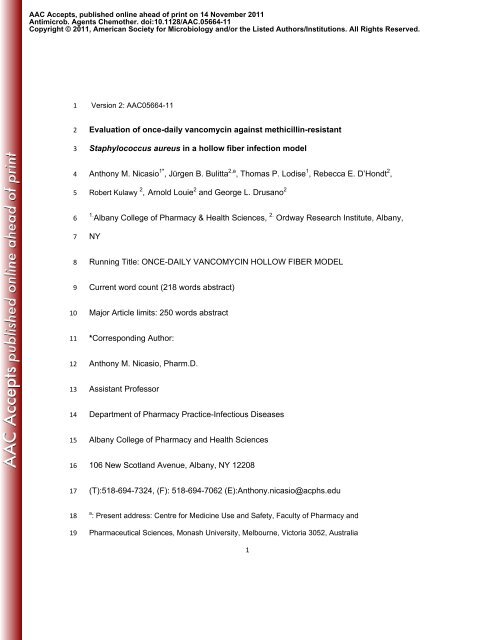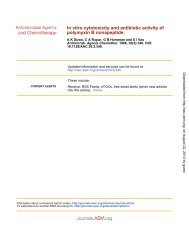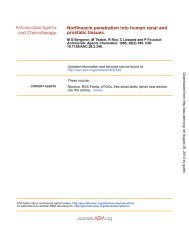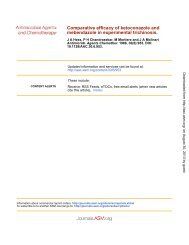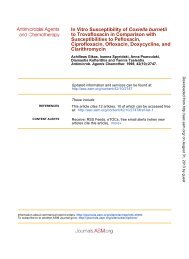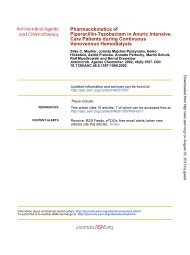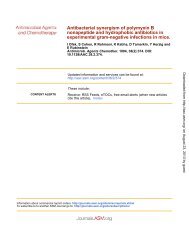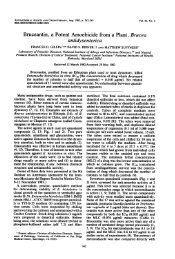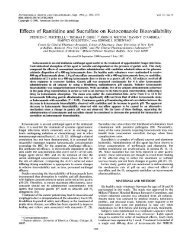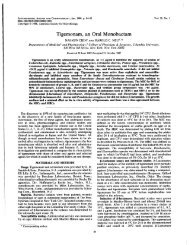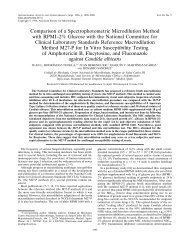Evaluation of once-daily vancomycin against methicillin-resistant ...
Evaluation of once-daily vancomycin against methicillin-resistant ...
Evaluation of once-daily vancomycin against methicillin-resistant ...
Create successful ePaper yourself
Turn your PDF publications into a flip-book with our unique Google optimized e-Paper software.
AAC Accepts, published online ahead <strong>of</strong> print on 14 November 2011<br />
Antimicrob. Agents Chemother. doi:10.1128/AAC.05664-11<br />
Copyright © 2011, American Society for Microbiology and/or the Listed Authors/Institutions. All Rights Reserved.<br />
1<br />
2<br />
3<br />
4<br />
5<br />
6<br />
7<br />
8<br />
9<br />
10<br />
11<br />
12<br />
13<br />
14<br />
15<br />
16<br />
17<br />
18<br />
19<br />
Version 2: AAC05664-11<br />
<strong>Evaluation</strong> <strong>of</strong> <strong>once</strong>-<strong>daily</strong> <strong>vancomycin</strong> <strong>against</strong> <strong>methicillin</strong>-<strong>resistant</strong><br />
Staphylococcus aureus in a hollow fiber infection model<br />
Anthony M. Nicasio 1* , Jürgen B. Bulitta 2,a , Thomas P. Lodise 1 , Rebecca E. D’Hondt 2 ,<br />
Robert Kulawy 2 , Arnold Louie 2 and George L. Drusano 2<br />
1. Albany College <strong>of</strong> Pharmacy & Health Sciences, 2. Ordway Research Institute, Albany,<br />
NY<br />
Running Title: ONCE-DAILY VANCOMYCIN HOLLOW FIBER MODEL<br />
Current word count (218 words abstract)<br />
Major Article limits: 250 words abstract<br />
*Corresponding Author:<br />
Anthony M. Nicasio, Pharm.D.<br />
Assistant Pr<strong>of</strong>essor<br />
Department <strong>of</strong> Pharmacy Practice-Infectious Diseases<br />
Albany College <strong>of</strong> Pharmacy and Health Sciences<br />
106 New Scotland Avenue, Albany, NY 12208<br />
(T):518-694-7324, (F): 518-694-7062 (E):Anthony.nicasio@acphs.edu<br />
a : Present address: Centre for Medicine Use and Safety, Faculty <strong>of</strong> Pharmacy and<br />
Pharmaceutical Sciences, Monash University, Melbourne, Victoria 3052, Australia<br />
1
20<br />
21<br />
22<br />
23<br />
24<br />
25<br />
26<br />
27<br />
28<br />
29<br />
30<br />
31<br />
32<br />
33<br />
34<br />
35<br />
36<br />
37<br />
38<br />
39<br />
40<br />
41<br />
Abstract<br />
For <strong>methicillin</strong>-<strong>resistant</strong> Staphylococcus aureus (MRSA) infections, data suggest that<br />
clinical response is significantly better if the total <strong>vancomycin</strong> AUC/MIC ratio is ≥ 400.<br />
While AUC/MIC ratio is the accepted pharmacokinetic/pharmacodynamic index for<br />
<strong>vancomycin</strong>, this target has been achieved using multiple <strong>daily</strong> doses. We are unaware<br />
<strong>of</strong> a systematically designed dose-fractionation study to compare the bactericidal<br />
activity <strong>of</strong> <strong>once</strong>-<strong>daily</strong> administration versus traditional twice <strong>daily</strong> administration.<br />
A dose-fractionation study was performed with <strong>vancomycin</strong> in the in vitro hollow-fiber<br />
infection model <strong>against</strong> a MRSA USA300 strain (MIC <strong>of</strong> 0.75 µg/mL) using an inoculum<br />
<strong>of</strong> ~10 6 CFU/mL. The three <strong>vancomycin</strong> regimens evaluated for 168 h were 2g every<br />
24h (Q24h) as 1h infusion, 1g Q12h as 1h infusion, and 2g Q24h as a continuous<br />
infusion. Free steady-state c<strong>once</strong>ntrations (assuming 45% binding) for a total <strong>daily</strong><br />
AUC/MIC ratio <strong>of</strong> ≥400 were simulated for all regimens. A validated liquid<br />
chromatography-tandem mass spectrometry method was used to determine<br />
<strong>vancomycin</strong> c<strong>once</strong>ntrations. Although <strong>once</strong>-<strong>daily</strong> and twice-<strong>daily</strong> dosage regimens<br />
exhibited total trough c<strong>once</strong>ntrations
42<br />
43<br />
44<br />
45<br />
Keywords: <strong>vancomycin</strong>, <strong>once</strong>-<strong>daily</strong> administration, hollow-fiber infection model, MRSA,<br />
<strong>methicillin</strong>-<strong>resistant</strong> Staphylococcus aureus, pharmacokinetics, pharmacodynamics, in<br />
vitro<br />
3
46<br />
47<br />
48<br />
49<br />
50<br />
51<br />
52<br />
53<br />
54<br />
55<br />
56<br />
57<br />
58<br />
59<br />
60<br />
61<br />
62<br />
63<br />
64<br />
65<br />
66<br />
67<br />
Introduction<br />
Given the dual threat <strong>of</strong> diminishing <strong>vancomycin</strong> efficacy <strong>against</strong> MRSA and<br />
recent reports <strong>of</strong> rising nephrotoxicity (10, 20) (albeit potentially due to concomitant<br />
dosing increases), new <strong>vancomycin</strong> dosing strategies are urgently needed. From a<br />
pharmacodynamic viewpoint, there is an opportunity to alter standard dosage regimen<br />
<strong>of</strong> <strong>vancomycin</strong> in clinical practice to optimize outcomes and minimize toxicity. Data<br />
suggest that killing by <strong>vancomycin</strong> is c<strong>once</strong>ntration-dependent and a near maximal<br />
bactericidal effect is achieved <strong>against</strong> MRSA when the ratio <strong>of</strong> the area under the total<br />
<strong>vancomycin</strong> c<strong>once</strong>ntration-time curve and the MIC (AUC:MIC) exceeds 400 (20). While<br />
an AUC:MIC <strong>of</strong> 400 is a well-recognized pharmacokinetic/pharmacodynamic (PK/PD)<br />
target for <strong>vancomycin</strong>, this target has been determined using multiple <strong>daily</strong> doses which<br />
has resulted in the default stance <strong>of</strong> using multiple <strong>daily</strong> dosing regimens in clinical<br />
practice (4,5,7,9,12,13,18,19). The possibility <strong>of</strong> <strong>once</strong>-<strong>daily</strong> administration is appealing<br />
from a PK/PD perspective as it affords the ability to achieve more robust AUCs in a<br />
defined interval (i.e. during the first 6-12 h) while minimizing trough c<strong>once</strong>ntrations,<br />
which predicts nephrotoxicity (10). However, we are unaware <strong>of</strong> a systematically<br />
designed dose-fractionation study that compared the bactericidal activity <strong>of</strong> <strong>once</strong>-<strong>daily</strong><br />
administration versus twice-<strong>daily</strong> administration <strong>of</strong> <strong>vancomycin</strong>.<br />
Our objective was to compare the rate and extent killing <strong>of</strong> MRSA USA300<br />
between <strong>vancomycin</strong> regimens at 2g/day given as 1h infusion every 12h or every 24h,<br />
or as continuous infusion in the hollow fiber infection model (HFIM). To our knowledge,<br />
4
68<br />
69<br />
70<br />
71<br />
72<br />
73<br />
74<br />
75<br />
76<br />
77<br />
78<br />
79<br />
80<br />
81<br />
82<br />
83<br />
84<br />
85<br />
86<br />
87<br />
this is the first dose-fractionation study that compared the bactericidal activity <strong>of</strong> <strong>once</strong>-<br />
<strong>daily</strong> versus twice-<strong>daily</strong> administration <strong>of</strong> <strong>vancomycin</strong>.<br />
Methods<br />
Bacterial isolates, susceptibility testing, and drug preparation:<br />
Vancomycin analytical grade powder was purchased from Fisher Scientific<br />
(Fairlawn, NJ). A sterile stock solution <strong>of</strong> 10,000 µg/mL was prepared in sterile water,<br />
diluted and aliquoted to the appropriate c<strong>once</strong>ntration, and stored at -80°C. MRSA<br />
pulse-field gel electrophoresis type USA300 (obtained as a gift from Brian Tsuji, SUNY<br />
Buffalo) was used for the susceptibility testing, time-kill studies, and HFIM. A quality<br />
control strain (<strong>methicillin</strong>-susceptible S. aureus, ATCC 25925) was only used for all<br />
susceptibility testing. Both <strong>of</strong> the strains were stored at -80°C in 20% glycerol and<br />
cation-adjusted Mueller-Hinton II broth (MHB) (BBL, Sparks, MD). Prior to<br />
experimentation, fresh isolates were grown on trypticase soy agar plates (TSA) with 5%<br />
sheep blood and incubated at 35°C for 24h.<br />
Susceptibility Testing:<br />
The susceptibility testing was performed in triplicate using the broth microdilution<br />
and agar dilution methods in MHB and MH agar following the CLSI guidelines (2).<br />
Dilutions were performed by arithmetic increments <strong>of</strong> 0.25μg/mL for the minimum<br />
inhibitory c<strong>once</strong>ntration (MIC) range <strong>of</strong> 0.25-2 μg/mL and increments <strong>of</strong> 1μg/mL for the<br />
MIC ≥2 μg/mL. The minimum bactericidal c<strong>once</strong>ntration (MBC) was determined by sub-<br />
5
88<br />
89<br />
90<br />
91<br />
92<br />
93<br />
94<br />
95<br />
96<br />
97<br />
98<br />
99<br />
100<br />
101<br />
102<br />
103<br />
104<br />
105<br />
106<br />
107<br />
108<br />
109<br />
culturing <strong>of</strong> broth from the microdilution wells that were previously incubated for 24h and<br />
plated onto TSA plates.<br />
Time-kill assay:<br />
A 48 hour time-kill experiment was conducted to evaluate the bactericidal activity<br />
<strong>of</strong> various c<strong>once</strong>ntrations <strong>of</strong> <strong>vancomycin</strong> <strong>against</strong> MRSA USA 300. The <strong>vancomycin</strong><br />
c<strong>once</strong>ntrations used in the time-kill study (0, 0.75, 2.25, 8, 16, 25, and 50 µg/mL)<br />
reflected the free <strong>vancomycin</strong> peak and trough c<strong>once</strong>ntrations for the dosing regimens<br />
evaluated in the HFIM. A starting inoculum was used <strong>of</strong> the same density as that used<br />
in the HFIM (10 5.8 CFU/mL) and the varying c<strong>once</strong>ntrations <strong>of</strong> <strong>vancomycin</strong> were added<br />
to conical tubes. The time-kill experiment was performed in a water-shaker bath at<br />
35°C and 100 rpm. Both MHB and drug were replaced after 24h by spinning the<br />
bacterial suspension, removal <strong>of</strong> the supernatant, and re-suspension in fresh (drug-<br />
containing) MHB in order to precisely maintain <strong>vancomycin</strong> c<strong>once</strong>ntrations and to<br />
maintain fresh MHB. Quantitative cultures were assessed at 0 (pre-dose), 3, 6, 24, 27,<br />
and 48h. Prior to culturing the bacterial samples on TSA agar, each sample was<br />
centrifuged and re-suspended twice with normal saline to remove <strong>vancomycin</strong>.<br />
Studies on the <strong>vancomycin</strong> less-susceptible subpopulations:<br />
The mutation frequencies <strong>of</strong> less susceptible subpopulations at different multiples<br />
<strong>of</strong> the MIC in agar were calculated as the ratio <strong>of</strong> colonies that grew onto drug<br />
containing agar divided by the colonies that grew onto drug-free agar as previously<br />
described by Louie et al. (11). Briefly, aliquots <strong>of</strong> the inoculum (1 - 5 ml) were plated<br />
6
110<br />
111<br />
112<br />
113<br />
114<br />
115<br />
116<br />
117<br />
118<br />
119<br />
120<br />
121<br />
122<br />
123<br />
124<br />
125<br />
126<br />
127<br />
128<br />
129<br />
130<br />
131<br />
onto agar containing 3X, 5X, 6X, 10X the baseline <strong>vancomycin</strong> agar MIC <strong>of</strong> the<br />
organism and incubated at 35°C. After as long as 72h <strong>of</strong> incubation, the colonies on the<br />
drug-containing media plates were enumerated and compared to the colony counts <strong>of</strong><br />
the total bacterial population previously assessed at 24h. Due to the limited bacterial<br />
growth on plates with 5x, 6x, and 10x MIC (data not shown), 3X MIC plates were used<br />
to determine the mutational frequency and less susceptible subpopulations in the HFIM.<br />
Mutation frequencies at 3X MIC were performed on at least four separate occasions.<br />
Hollow fiber infection model (HFIM):<br />
A description <strong>of</strong> the hollow-fiber bioreactor (Cellulosic cartridge, FiberCell<br />
System, Inc., Fredrick, MD) has been detailed in previous publications (24). Along with<br />
<strong>vancomycin</strong> being injected into the central compartment, a continuous flow <strong>of</strong> fresh<br />
MHB was also infused in order to represent the human simulated terminal half-life <strong>of</strong><br />
<strong>vancomycin</strong>. In order to maintain an isovolumetric environment, MHB was removed<br />
from the central reservoir into a waste reservoir via a peristaltic pump (Masterflex; Cole-<br />
Palmer Instrument Co., Chicago, IL). In order to inoculate the HFIM, MRSA was<br />
injected and confined to the hollow-fiber cartridge (i.e. the extracapillary space <strong>of</strong> the<br />
hollow fiber system). Broth medium including nutrients and <strong>vancomycin</strong> was exchanged<br />
by a rapid intercompartmental clearance between the central reservoir and the hollow<br />
fiber cartridge.<br />
Schedule-response experiment:<br />
7
132<br />
133<br />
134<br />
135<br />
136<br />
137<br />
138<br />
139<br />
140<br />
141<br />
142<br />
143<br />
144<br />
145<br />
146<br />
147<br />
148<br />
149<br />
150<br />
151<br />
152<br />
153<br />
154<br />
A dose-fractionation study was performed in duplicate with the same USA300<br />
MRSA isolate using the HFIM in a humidified incubator at 35°C. The isolate was taken<br />
from the -80° freezer and sub-cultured twice on TSA plates prior to preparation <strong>of</strong> the<br />
bacterial suspension. The inoculum was prepared by taking 3–5 freshly grown mid-size<br />
colonies and placing them into fresh MHB at 35°C. The inoculum was grown to<br />
logarithmic state and diluted with MHB to approximately 10 5.8 CFU/mL; this was<br />
measured with a spectrophotometer to an optical density <strong>of</strong> 630nm.<br />
Twelve milliliters <strong>of</strong> the inoculum were injected into the peripheral port <strong>of</strong> each <strong>of</strong><br />
the four hollow-fiber cartridges. The four cartridges (for each <strong>of</strong> the two experiments)<br />
consisted <strong>of</strong> a growth control (drug-free) and three <strong>vancomycin</strong> dosing arms that were<br />
designed to achieve a total AUC/MIC ratio <strong>of</strong> ≥400 over 168 h. The three <strong>vancomycin</strong><br />
regimens simulated the steady-state human c<strong>once</strong>ntrations <strong>of</strong> unbound <strong>vancomycin</strong> at a<br />
percent protein binding <strong>of</strong> 45% (1, 26). The mean pharmacokinetic parameters and<br />
CLCR values for these <strong>vancomycin</strong> regimens were derived from a <strong>vancomycin</strong><br />
population pharmacokinetic model (6, 21, 22). A glomerular filtration rate <strong>of</strong> 88 mL/min<br />
to reflect elderly patients with normal renal function yielded a total <strong>vancomycin</strong><br />
clearance <strong>of</strong> 5.0 L/h. For a <strong>daily</strong> dose <strong>of</strong> 2 g, this yielded a total drug AUC <strong>of</strong> 400<br />
µg•h/mL and an unbound AUC <strong>of</strong> 220 µg•h/mL. The half-life simulated in the HFIM was<br />
approximately 4.8 h. The <strong>vancomycin</strong> dosing arms <strong>of</strong> 1g every 12h, 2g every 24h<br />
(intermittent 1h infusion), and 2g every 24h (continuous-infusion) were achieved by<br />
simulating a peak non-protein bound (free) drug c<strong>once</strong>ntration <strong>of</strong> 30.5, 18.2, 9.2 µg/mL<br />
(16). To achieve the targeted half-life for <strong>vancomycin</strong>, the central compartment volume<br />
was 485 mL and the medium within the compartment was isovolumetrically replaced<br />
8
155<br />
156<br />
157<br />
158<br />
159<br />
160<br />
161<br />
162<br />
163<br />
164<br />
165<br />
166<br />
167<br />
168<br />
169<br />
170<br />
171<br />
172<br />
173<br />
174<br />
175<br />
with fresh MHB at a flow rate <strong>of</strong> 1.17 ml/min. Vancomycin c<strong>once</strong>ntration samples for<br />
each <strong>of</strong> the drug-containing arms were acquired at ≥12 different timepoints, mainly<br />
within the first 48h, from the drug sampling port <strong>of</strong> the central reservoir. These<br />
c<strong>once</strong>ntrations were later confirmed with a validated liquid chromatography-tandem<br />
mass spectrometry (LC/MS/MS) method performed at Ordway Research Institute<br />
(Albany, NY).<br />
Viable counts <strong>of</strong> the total population were determined at 0 (pre-dose), 6, 24, 30,<br />
72, 96, 120, 144, and 168h. Viable counts <strong>of</strong> less-susceptible population(s) on 3x MIC<br />
plates were determined every 24 h. Samples <strong>of</strong> the inoculum were washed twice with<br />
normal saline to minimize drug carry-over. The samples were serially diluted 10-fold in<br />
normal saline and cultured onto TSA for each <strong>of</strong> the timepoints. Agar plates were<br />
incubated for 24h (TSA plates) or 72h (<strong>vancomycin</strong> agar plates) at 35°C. A volume <strong>of</strong><br />
200 µL was plated for all samples for which the lower limit <strong>of</strong> detection was 6 colonies<br />
(1.5 log10 CFU/mL).<br />
To determine the susceptibility, and therefore to confirm the development <strong>of</strong><br />
resistance, MICs were performed in duplicate on colonies that were obtained at each<br />
timepoint from each experimental arm, excluding the control arm.<br />
LC/MS/MS assay:<br />
The samples (<strong>vancomycin</strong> in MHB) were diluted with high pressure liquid<br />
chromatography water (0.050mL sample into 1.00mL 50:50 methanol:water), and were<br />
9
176<br />
177<br />
178<br />
179<br />
180<br />
181<br />
182<br />
183<br />
184<br />
185<br />
186<br />
187<br />
analyzed by LC/MS/MS. The LC/MS/MS system was comprised <strong>of</strong> a Shimadzu<br />
Prominence UFLC system and a Thermo Scientific TSQ Vantage LC/MS/MS.<br />
Chromatographic separation was performed using a Thermo Scientific Hypersil<br />
C8 column, 5 µm, 50 x 3.0 mm column and a mobile phase consisting <strong>of</strong> 85% 5 mM<br />
ammonium acetate pH 3.5 and 15% methanol, at a flow rate <strong>of</strong> 0.6 ml/min. Vancomycin<br />
c<strong>once</strong>ntrations were obtained using LC/MS/MS monitoring the MS/MS transition m/z<br />
725 (doubly charged ion) → m/z 144. Analysis run time was 5.0 minutes. The assay<br />
was linear over a range <strong>of</strong> 0.05 – 50.0 µg/ml (r 2 > 0.995). The inter-day precision (%CV)<br />
for the quality control samples (which were analyzed in triplicate at three c<strong>once</strong>ntrations<br />
[1.0, 5.0, and 10.0 µg/mL]) ranged from 2.68 to 3.40%; the accuracy (%recovery)<br />
ranged from 97.5 to 101%.<br />
10
188<br />
189<br />
190<br />
191<br />
192<br />
193<br />
194<br />
195<br />
196<br />
197<br />
198<br />
199<br />
200<br />
201<br />
202<br />
203<br />
204<br />
205<br />
206<br />
207<br />
208<br />
209<br />
Results<br />
Susceptibility and mutation frequency: The agar dilution and broth microdilution<br />
modal MICs for the USA300 MRSA strain were both 0.75 µg/mL; the MBC was 1<br />
µg/mL. The log10 mutation frequency ranged from -5.8 to -6.9 for agar plates with 3x the<br />
baseline MIC and from -7.1 to -7.7 for 5x MIC based on mutation frequencies<br />
determined on three different days. The less-susceptible sub-populations that grew in<br />
the presence <strong>of</strong> 3X MIC exhibited a higher MIC (2-3 µg/mL).<br />
Time-kill studies: The rate <strong>of</strong> bacterial killing was 1.5 to 2 log10 killing at 6h for all<br />
tested <strong>vancomycin</strong> c<strong>once</strong>ntrations. Between 6 and 24h, extensive regrowth was<br />
observed for 0.75 µg/mL. Bactericidal activity (i.e., ≥3 log-kill) was observed for all<br />
c<strong>once</strong>ntrations within 2.25 to 50 µg/mL and the overall extent <strong>of</strong> killing and lack <strong>of</strong><br />
regrowth up to 48 h for these c<strong>once</strong>ntrations was comparable (Figure 1).<br />
Hollow fiber infection model: The observed <strong>vancomycin</strong> c<strong>once</strong>ntration time<br />
pr<strong>of</strong>iles for the three <strong>vancomycin</strong> dosage regimens are provided in Figure 2. The free-<br />
drug AUCs (determined by the linear trapezoidal rule) were well comparable between<br />
regimens with 262.2 ± 29.5 for q24h dosing, 242.1 ± 31 for q12h dosing, and 244.2 ±<br />
1.3 for continuous infusion.<br />
All three <strong>vancomycin</strong> dosing regimens with a total AUC/MIC ratio <strong>of</strong> ≥400 had a<br />
comparable bactericidal activity <strong>against</strong> MRSA. As shown in Figure 3, <strong>vancomycin</strong><br />
experienced a slow rate <strong>of</strong> kill within the first 6h (-0.91 to -1.24 log10 CFU/mL) and<br />
attained bactericidal activity (-3.27 to -3.57 log10 CFU/mL) at 24h which was maintained<br />
up to 168h. Although bactericidal activity was achieved with all <strong>of</strong> the <strong>vancomycin</strong><br />
11
210<br />
211<br />
212<br />
213<br />
214<br />
215<br />
216<br />
217<br />
218<br />
219<br />
dosing regimens in the HFIM, it is important to note that sterility was not attained. Of<br />
the colonies that did exist near or above the limit <strong>of</strong> detection for any <strong>of</strong> the dosing<br />
regimens, the MICs <strong>of</strong> 0.75-1 µg/mL did not change from baseline. Based on the<br />
results from the drug-containing agar with <strong>vancomycin</strong> at 3X MIC, all dosing regimens<br />
prevented breakthrough <strong>of</strong> non-susceptible sub-populations for each <strong>of</strong> the<br />
experimental treatment arms during the seven day HFIM experimental period. No<br />
<strong>resistant</strong> colonies were found on 3x MIC plates for the drug treatment arms, whereas<br />
the growth control showed a number <strong>of</strong> colonies in agreement with the mutation<br />
frequency on 3x MIC plates.<br />
12
220<br />
221<br />
222<br />
223<br />
224<br />
225<br />
226<br />
227<br />
228<br />
229<br />
230<br />
231<br />
232<br />
233<br />
234<br />
235<br />
236<br />
237<br />
238<br />
239<br />
240<br />
241<br />
242<br />
Discussion<br />
After half a century <strong>of</strong> clinical use, the optimal mode <strong>of</strong> administration has not yet<br />
been elucidated for <strong>vancomycin</strong>. Although <strong>vancomycin</strong> is classified as an AUC/MIC<br />
ratio-driven antimicrobial, the data that support this were derived from multiple <strong>daily</strong><br />
dosing regimens (4, 5, 7, 9, 12, 13, 18, 19). To our knowledge, this is the first<br />
contemporary dose-fractionation study designed to evaluate whether killing by<br />
<strong>vancomycin</strong> is driven by the AUC/MIC ratio. Overall, when dosed to simulate a total<br />
AUC/MIC ratio <strong>of</strong> ≥400 in the HFIM, we were able to demonstrate comparable bacterial<br />
efficacy between <strong>once</strong>-<strong>daily</strong> <strong>vancomycin</strong> administration, continuous infusion, and twice-<br />
<strong>daily</strong> administration. Within each <strong>of</strong> the dosing regimens, <strong>vancomycin</strong> exhibited<br />
bactericidal activity after 24h and maintained this activity for seven consecutive days. In<br />
addition to the sustained bactericidal effects, all three regimens suppressed the<br />
development <strong>of</strong> non-susceptible subpopulations and were able to maintain MIC values<br />
≤1 µg/mL throughout the seven days.<br />
The exploration <strong>of</strong> dosing strategies to enhance the utility <strong>of</strong> an antibiotic agent is<br />
not a new approach (23, 25). This approach was utilized with daptomycin and was<br />
pivotal in the discovery that skeletal muscle toxicity issues were associated with more<br />
frequent dosing rather than a maximum c<strong>once</strong>ntration (15). Similar findings were<br />
exhibited with aminoglycosides where it was determined that more frequent dosing<br />
intervals led to higher incidences <strong>of</strong> nephrotoxicity (17). To date, we are only aware <strong>of</strong><br />
one clinical and one in vitro study to compare <strong>vancomycin</strong> <strong>once</strong>-<strong>daily</strong> versus twice-<strong>daily</strong><br />
dosing regimens. In the clinical study, which focused on efficacy and safety, the<br />
outcomes were comparable between <strong>once</strong>-<strong>daily</strong> and twice-<strong>daily</strong> groups; however, it<br />
13
243<br />
244<br />
245<br />
246<br />
247<br />
248<br />
249<br />
250<br />
251<br />
252<br />
253<br />
254<br />
255<br />
256<br />
257<br />
258<br />
259<br />
260<br />
261<br />
262<br />
263<br />
264<br />
265<br />
should be noted that the patients studied were not severely ill (3). In the in vitro study,<br />
Houlihan et al. utilized a simulated endocarditis vegetation model at a high initial<br />
inoculum (10 9 CFU/mL) in order to investigate the use <strong>of</strong> 2g-per-day regimen,<br />
administered as <strong>once</strong>-<strong>daily</strong>, twice-<strong>daily</strong>, or continuous-infusion, for a total <strong>of</strong> 72h (8).<br />
Similar to our study, the authors observed that trough levels did not dictate bacterial<br />
efficacy despite a bacterial inoculum as high as 10 9 CFU/mL when the total AUC/MIC<br />
ratios associated with the dosing regimens were all >400.<br />
Our results carry important implications for clinical practice. First, they challenge<br />
the need to obtain frequent trough c<strong>once</strong>ntrations: bactericidal efficacy was observed<br />
despite a trough c<strong>once</strong>ntration that was well below the lowest recommended total<br />
trough c<strong>once</strong>ntration <strong>of</strong> 10µg/mL for the total <strong>daily</strong> <strong>vancomycin</strong> dose <strong>of</strong> 2g given as a<br />
<strong>once</strong>-<strong>daily</strong> dosing regimen. Second, they call into question the need for trough<br />
c<strong>once</strong>ntrations <strong>of</strong> 15-20 µg/mL for all patients. Our results are similar to that <strong>of</strong> another<br />
study by our group (16) which found that regimens producing trough values ≥ 15µg/mL<br />
were not always necessary to provide a total AUC/MIC ratio <strong>of</strong> ≥ 400, especially if the<br />
<strong>vancomycin</strong> MIC <strong>of</strong> the MRSA is ≤ 1 µg/mL.<br />
A second clinical implication <strong>of</strong> our data is the convenience associated with <strong>once</strong>-<br />
<strong>daily</strong> administration <strong>of</strong> <strong>vancomycin</strong>. Multiple <strong>daily</strong> dosing <strong>of</strong> a drug is inconvenient due<br />
to the increased use <strong>of</strong> nursing time and the increased risk <strong>of</strong> medication errors<br />
associated with the frequency <strong>of</strong> administration and the time intervals between doses<br />
(14). The administration <strong>of</strong> <strong>vancomycin</strong> as a <strong>once</strong>-<strong>daily</strong> drug would alleviate these<br />
inconveniences, in addition to facilitating the transition to an outpatient treatment<br />
protocol.<br />
14
266<br />
267<br />
268<br />
269<br />
270<br />
271<br />
272<br />
273<br />
274<br />
275<br />
276<br />
277<br />
278<br />
279<br />
280<br />
281<br />
282<br />
Finally, by minimizing the trough c<strong>once</strong>ntration needed to achieve the desired<br />
AUC/MIC ratio, one may be able to reduce the risk <strong>of</strong> nephrotoxicity associated with<br />
<strong>vancomycin</strong>. Since the <strong>daily</strong> AUC value is independent <strong>of</strong> dosing frequency (16), and<br />
nephrotoxicity appears to be linked to the trough c<strong>once</strong>ntration (10), it may be<br />
advantageous to move from multiple <strong>daily</strong> dosing to <strong>once</strong>-<strong>daily</strong> <strong>vancomycin</strong> dosing in<br />
clinical practice. This approach needs explicit testing in randomized trials.<br />
Overall, at a moderate inoculum, we demonstrated with a HFIM that <strong>vancomycin</strong><br />
given as a <strong>once</strong>-<strong>daily</strong> dosing regimen exhibited similar bactericidal activity as conferred<br />
by continuous infusion and twice-<strong>daily</strong> dosing regimens <strong>against</strong> MRSA USA 300 (MIC:<br />
0.75 µg/mL) while maintaining the same AUC/MIC ratio <strong>of</strong> ≥400. Vancomycin was able<br />
to maintain efficacy and suppress the development <strong>of</strong> non-susceptible subpopulations<br />
during a clinically relevant treatment duration <strong>of</strong> seven days. Therefore, these results<br />
question the need for aggressive <strong>vancomycin</strong> trough c<strong>once</strong>ntrations <strong>of</strong> 15-20 µg/mL for<br />
all infections and suggests that the efficacy <strong>of</strong> <strong>vancomycin</strong> is not predicated on the<br />
trough c<strong>once</strong>ntration but rather the AUC when the MIC <strong>of</strong> the pathogen is
283<br />
284<br />
285<br />
286<br />
287<br />
288<br />
289<br />
290<br />
291<br />
292<br />
293<br />
294<br />
295<br />
296<br />
297<br />
298<br />
Acknowledgments:<br />
We would like to thank Brian van Scoy and David Brown for their technical assistance,<br />
and Allison Krug MPH for her editorial support.<br />
Potential Conflicts <strong>of</strong> Interest:<br />
A.M.N., R.E.D., R.K., and A.L. have no conflicts <strong>of</strong> interest. JBB has received grant<br />
support from Pfizer and Trius Therapeutics. T.P.L. is a consultant and speaker for<br />
Pfizer, Cubist Pharmaceuticals, Astellas, and Forest. T.P.L. has received grant support<br />
from Astellas, Cubist, and Pfizer. G.L.D. is a consultant for Forest, Cerexa<br />
Pharmaceuticals and AstraZeneca. G.L.D. has received grant support from Forest.<br />
Funding:<br />
This study was non-funded.<br />
Presented in part:<br />
Interscience Conference on Antimicrobial Agents and Chemotherapy, 51 st Annual<br />
Meeting, Chicago, IL, September, 2011.<br />
16
299<br />
300<br />
301<br />
302<br />
303<br />
304<br />
305<br />
306<br />
307<br />
308<br />
309<br />
310<br />
311<br />
312<br />
313<br />
314<br />
315<br />
316<br />
317<br />
318<br />
319<br />
References<br />
1. Butterfield, J.M., N. Patel, M.P. Pai, T.G. Rosano, G.L. Drusano, and T.P.<br />
Lodise.. 2011. Refining <strong>vancomycin</strong> protein binding estimates: identification <strong>of</strong> clinical<br />
factors that influence protein binding. Antimicrob. Agents Chemother.55:4277-82<br />
2. Clinical and Laboratory Standards Institute. 2009. Methods for dilution<br />
antimicrobial susceptibility tests for bacteria that grow aerobically; CLSI documents. 8 th<br />
ed. M07-A8. Clinical and Laboratory Standards Institute, Wayne, PA.<br />
3. Cohen, E., A. Dadashev, M. Drucker, Z. Samra, E. Rubinstein, and M. Garty.<br />
2002.Once-<strong>daily</strong> versus twice-<strong>daily</strong> intra- venous administration <strong>of</strong> <strong>vancomycin</strong> for<br />
infections in hospitalized patients. J. Antimicrob. Chemother.49:155-160.<br />
4. Craig, W.A. 1998.Pharmacokinetic/pharmacodynamic parameters: rationale for<br />
antibacterial dosing <strong>of</strong> mice and men. Clin. Infect. Dis. 26:1‐10; quiz 1‐2.<br />
5. Craig, W.A. 2003. Basic pharmacodynamics <strong>of</strong> antibacterials with clinical<br />
applications to the use <strong>of</strong> beta‐lactams, glycopeptides, and linezolid. Infect. Dis. Clin.<br />
North Am. 17:479‐501.<br />
6. Drusano G.L., P. G. Ambrose, S. M. Bhavnani, C. M. Rubino, A. Forrest,<br />
A. Louie, T. P. Lodise, and K. A. Rodvold. 2007. Vancomycin dose recommendations<br />
for hospital-, ventilator- or health care-associated pneumonia and the attainment <strong>of</strong><br />
<strong>vancomycin</strong> trough c<strong>once</strong>ntrations <strong>of</strong> 15 – 20 mg/L: cognitive dissonance. 45th Annual<br />
Meeting <strong>of</strong> the Infectious Diseases Society <strong>of</strong> America (San Diego), Arlington, VA:<br />
Infectious Diseases Society <strong>of</strong> America.<br />
17
320<br />
321<br />
322<br />
323<br />
324<br />
325<br />
326<br />
327<br />
328<br />
329<br />
330<br />
331<br />
332<br />
333<br />
334<br />
335<br />
336<br />
337<br />
338<br />
339<br />
340<br />
341<br />
7. Harigaya, Y., J.B. Bulitta, A. Forrest, G. Sakoulas, A.J. Lesse, J.M. Mylotte, and<br />
B.T. Tsuji. 2009. Pharmacodynamics <strong>of</strong> <strong>vancomycin</strong> at simulated epithelial lining fluid<br />
c<strong>once</strong>ntrations <strong>against</strong> <strong>methicillin</strong>‐<strong>resistant</strong> Staphylococcus aureus (MRSA):<br />
implications for dosing in MRSA pneumonia. Antimicrob. Agents Chemother.<br />
53:3894‐901.<br />
8. Houlihan, H.H., R. C. Mercier, and M.J. Rybak. 1997. Pharmacodynamics <strong>of</strong><br />
<strong>vancomycin</strong> alone and in combination with gentamicin at various dosing intervals<br />
<strong>against</strong> <strong>methicillin</strong>-<strong>resistant</strong> Staphylococcus aureus-infected fibrin-platelet clots in an in<br />
vitro infection model. Antimicrob. Agents Chemother. 41:2497-501<br />
9. LaPlante, K.L., S.N. Leonard, D.R. Andes, W.A. Craig, and M.J. Rybak. 2008.<br />
Activities <strong>of</strong> clindamycin, daptomycin, doxycycline, linezolid,<br />
trimethoprim‐sulfamethoxazole, and <strong>vancomycin</strong> <strong>against</strong> community‐associated<br />
<strong>methicillin</strong>‐<strong>resistant</strong> Staphylococcus aureus with inducible clindamycin resistance in<br />
murine thigh infection and in vitro pharmacodynamic models. Antimicrob. Agents<br />
Chemother. 52:2156‐62.<br />
10. Lodise, T.P., N. Patel, B.M. Lomaestro, K.A. Rodvold, and G.L. Drusano. 2009.<br />
Relationship between initial <strong>vancomycin</strong> c<strong>once</strong>ntration-time pr<strong>of</strong>ile and nephrotoxicity<br />
among hospitalized patients. Clin. Infect. Dis. 49:507-14.<br />
11. Louie, A., D.L. Brown, W. Liu, R.W. Kulawy, M.R. Deziel, and G.L. Drusano..<br />
2007. In vitro infection model characterizing the effect <strong>of</strong> efflux pump inhibition on<br />
prevention <strong>of</strong> resistance to lev<strong>of</strong>loxacin and cipr<strong>of</strong>loxacin in Streptococcus pneumoniae.<br />
Antimicrob. Agents Chemother.51:3988-4000.<br />
18
342<br />
343<br />
344<br />
345<br />
346<br />
347<br />
348<br />
349<br />
350<br />
351<br />
352<br />
353<br />
354<br />
355<br />
356<br />
357<br />
358<br />
359<br />
360<br />
361<br />
362<br />
12. Lubenko, I.Y., E.V. Strukova, M.V. Smirnova, S.N. Vostrov, Y.A. Portnoy, S.H.<br />
Zinner, and A.A. Firsov. 2008.Telavancin and <strong>vancomycin</strong> pharmacodynamics with<br />
Staphylococcus aureus in an in vitro dynamic model. J. Antimicrob.<br />
Chemother.62:1065‐9.<br />
13. Moise‐Broder, P.A., A. Forrest, M.C. Birmingham, and J.J. Schentag. 2004.<br />
Pharmacodynamics <strong>of</strong> <strong>vancomycin</strong> and other antimicrobials in patients with<br />
Staphylococcus aureus lower respiratory tract infections. Clin.<br />
Pharmacokinet.43:925‐42<br />
14. Nettleman, M.D., and M.J. Bock. 1996. The epidemiology <strong>of</strong> missed medication<br />
doses in hospitalized patients. Clin. Perform. Qual. Health Care.4:148–53<br />
15. Oleson, F.B. Jr., C.L. Berman, J.B. Kirkpatrick, K.S. Regan, J.J. Lai, and F.P.<br />
Tally. 2000. Once-<strong>daily</strong> dosing in dogs optimizes daptomycin safety. Antimicrob.<br />
Agents Chemother.44: 2948-53.<br />
16. Patel, N., M.P. Pai, K.A. Rodvold, B. Lomaestro, G.L. Drusano, and T.P. Lodise.<br />
2011.Vancomycin: we can’t get there from here. Clin. Infect. Dis.52:969-974.<br />
17. Rybak, M.J., B.J. Abate, S.L. Kang, M.J. Ruffing, S.A. Lerner, and G.L.<br />
Drusano.1999. Prospective evaluation <strong>of</strong> the effect <strong>of</strong> an aminoglycoside dosing<br />
regimen on rates <strong>of</strong> observed nephrotoxicity and ototoxicity. Antimicrob. Agents<br />
Chemother. 43:1549–55<br />
18. Rybak, M.J. 2006.The pharmacokinetic and pharmacodynamic properties <strong>of</strong><br />
<strong>vancomycin</strong>. Clin. Infect. Dis.42. Suppl 1:S35‐9.<br />
19
363<br />
364<br />
365<br />
366<br />
367<br />
368<br />
369<br />
370<br />
371<br />
372<br />
373<br />
374<br />
375<br />
376<br />
377<br />
378<br />
379<br />
380<br />
381<br />
382<br />
383<br />
19. Rybak, M.J. 2006. Pharmacodynamics: relation to antimicrobial resistance. Am. J.<br />
Med.119 (6 Suppl 1):S37‐44; discussion S62‐70.<br />
20. Rybak, M.J, B. Lomaestro, J.C. Rotschafer, R. Moellering Jr., W. Craig, M.<br />
Billeter, J.R. Dalovisio, and D.P. Levine. 2009.Therapeutic monitoring <strong>of</strong> <strong>vancomycin</strong><br />
in adult patients: a consensus review <strong>of</strong> the American Society <strong>of</strong> Health-System<br />
Pharmacists, the Infectious Diseases Society <strong>of</strong> America, and the Society <strong>of</strong> Infectious<br />
Diseases Pharmacists. Am. J. Health Syst. Pharm.66:82-98.<br />
21. Rodvold, K.A., R.A. Blum, J.H. Fischer, H.Z. Zokufa, J.C. Rotschafer,<br />
K.B. Crossley, and L.J. Riff . 1988.Vancomycin pharmacokinetics in patients with<br />
various degrees <strong>of</strong> renal function. Antimicrob. Agents Chemother.32:848-52.<br />
22. Rodvold, K.A., R.D. Pryka, M. Garrison, and J.C. Rotschafer. 1989. <strong>Evaluation</strong> <strong>of</strong><br />
a two-compartment Bayesian forecasting program for predicting <strong>vancomycin</strong><br />
c<strong>once</strong>ntrations. Ther. Drug Monit.11:269-75.<br />
23. Tally F.P., M. Zeckel, M.M. Wasilewski, C. Carini, C.L. Berman,<br />
G.L. Drusano, and F.B. Oleson Jr. 1999. Daptomycin: a novel agent for Gram-positive<br />
infections. Expert Opin. Investig. Drugs.8:1223-38.<br />
24. Tam, V.H., A. Louie, M.R. Deziel, W. Liu, and G.L. Drusano. 2005. Bacterial-<br />
population responses to drug-selective pressure: examination <strong>of</strong> garenoxacin’s effect on<br />
Pseudomonas aeruginosa. J. Infect. Dis.192:420–8.<br />
25. ter Braak, E.W., P.J. de Vries, K.P. Bouter, S.G. van der Vegt,<br />
G.C. Dorrestein, J.W. Nortier, A. van Dijk, R.P. Verkooyen, and H.A. Verbrugh.<br />
20
384<br />
385<br />
386<br />
387<br />
388<br />
389<br />
390<br />
391<br />
392<br />
1990.Once-<strong>daily</strong> dosing regimen for aminoglycoside plus β-lactam combination therapy<br />
<strong>of</strong> serious bacterial infections: comparative trial <strong>of</strong> netilmicin plus ceftriaxone. Am. J.<br />
Med. 89:58–66<br />
26. Torrico, M., L. Aguilar, D. Sevillano, M.J. Giménez, L. Alou, N. González, F.<br />
Cafini, R. Cleeland, and J. Prieto. 2011. Activity <strong>of</strong> simulated serum c<strong>once</strong>ntrations <strong>of</strong><br />
daptomycin versus <strong>vancomycin</strong> during the first 24h <strong>of</strong> treatment in the presence <strong>of</strong><br />
physiological albumin c<strong>once</strong>ntrations <strong>against</strong> <strong>vancomycin</strong>-susceptible, -tolerant or -<br />
intermediate-<strong>resistant</strong> Staphylococcus aureus. Int. J. Antimicrob. Agents. 37:332-8.<br />
21
393<br />
394<br />
395<br />
396<br />
397<br />
398<br />
Fig 1: Activity <strong>of</strong> <strong>vancomycin</strong> tested at c<strong>once</strong>ntrations ranging from 0.75 to<br />
Bacterial Density (log 10 CFU/mL)<br />
10<br />
8<br />
6<br />
4<br />
2<br />
50µg/mL in a static time-kill assay <strong>against</strong> USA300 MRSA strain at an<br />
inoculum <strong>of</strong> 10 5.8 CFU/mL.<br />
0 12 24 36 48<br />
Time (h)<br />
22<br />
growth control<br />
0.75μg/mL<br />
2.25μg/mL<br />
8μg/mL<br />
16μg/mL<br />
25μg/mL<br />
50μg/mL
399<br />
400<br />
401<br />
402<br />
403<br />
404<br />
405<br />
406<br />
407<br />
408<br />
409<br />
410<br />
Fig 2. Observed <strong>vancomycin</strong> c<strong>once</strong>ntration time pr<strong>of</strong>iles for (A) 2g every 24h, (B)<br />
(A)<br />
Vancomycin C<strong>once</strong>ntration (μg/mL<br />
(B)<br />
Vancomycin C<strong>once</strong>ntration (μg/mL)<br />
25<br />
20<br />
15<br />
10<br />
5<br />
40<br />
35<br />
30<br />
25<br />
20<br />
15<br />
10<br />
5<br />
1g every 12h, (C) 2g continuous infusion in the HFIM.<br />
0<br />
0 20 40 100 120 140 160 180 200<br />
Time (hr)<br />
Time (hr)<br />
0<br />
0 20 40 100 120 140 160 180 200<br />
23
411<br />
412<br />
C)<br />
Vancomycin C<strong>once</strong>ntration (μg/mL)<br />
40<br />
30<br />
20<br />
10<br />
0<br />
0 20 40 100 120 140 160 180 200<br />
Time (hr)<br />
24
413<br />
414<br />
415<br />
416<br />
417<br />
418<br />
419<br />
420<br />
421<br />
422<br />
423<br />
Fig 3. An in vitro HFIM was used to compare three different <strong>vancomycin</strong> regimens<br />
Bacterial D ensity (log 10 CFU/mL)<br />
14<br />
12<br />
10<br />
8<br />
6<br />
4<br />
2<br />
(and a growth control): 2g every 24h, 1g every 12h, and 2g continuous-<br />
infusion. The figure show the average ± standard deviation <strong>of</strong> the log 10<br />
CFU/mL from 0 to 168h based on two replicated for all cohorts except for the<br />
2g continuous infusion for that one replicate was available.<br />
0<br />
0 20 40 60 80 100 120 140 160 180<br />
Time (hr)<br />
25<br />
Control<br />
2g every 24h<br />
1g every 12h<br />
2g continous infusion


